Introduction: Bridging Nations Through Art
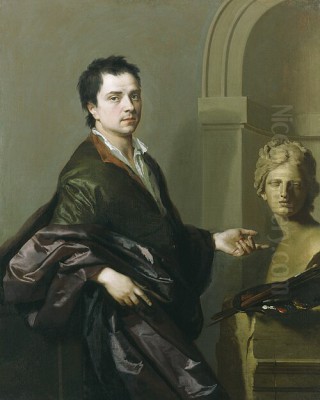
Michael Dahl (c. 1659–1743) stands as a significant figure in the landscape of late Baroque portraiture, a Swedish-born artist who carved out a remarkably successful and influential career primarily in England. Arriving during a vibrant period for the arts, Dahl navigated the competitive London scene, eventually rising to become one of the most sought-after portrait painters of his generation. His work, characterized by its elegance, dignity, and sensitive rendering of character, provides a fascinating window into the aristocracy and royalty of late Stuart and early Georgian England. While often compared to his main rival, Sir Godfrey Kneller, Dahl developed a distinct style that earned him considerable acclaim and a lasting place in art history.
Early Life and Artistic Formation in Sweden
Born in Stockholm around 1659, the precise details of Michael Dahl's early life remain somewhat shrouded in mystery, contributing to the enigmatic aura that surrounds his formative years. Sources suggest his family background might have been modest, with some accounts hinting that his mother, possibly from the lower-middle class, made considerable sacrifices to ensure her son received an education, potentially facilitating his later move to London. What is clearer is his early immersion in the artistic environment of the Swedish capital.
Dahl received his initial training under notable figures within the Swedish art establishment. His primary teacher is widely considered to be David Klöcker Ehrenstrahl (1628–1698), the dominant figure in Swedish painting at the time and court painter to the Swedish monarchy. Ehrenstrahl, himself German-born but central to the development of Swedish Baroque art, would have imparted a solid foundation in the prevailing European styles. Some sources also mention Martin Hannibal (active late 17th century) as another early influence or teacher. An alternative source names Ernst Klocke, another artist connected to the Swedish court, as an early mentor, highlighting the sometimes conflicting details surrounding Dahl's education. Ehrenstrahl's studio was a hub of activity, though historical accounts describe Dahl himself as somewhat "mysterious and puzzling" during this period, perhaps hinting at an independent spirit even in his youth.
The Grand Tour: England, Paris, and Rome
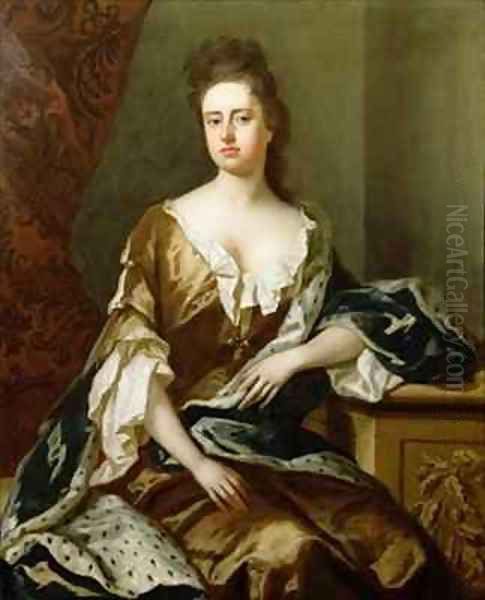
Like many ambitious artists of his era, Dahl recognized the need for broader experience and exposure to the major art centers of Europe. Around 1682, he made the pivotal decision to leave Sweden and travel to London. England, particularly London, was becoming an increasingly important center for portraiture, attracting artists from across the continent. This initial period in England likely served as an orientation, allowing him to observe the prevailing tastes and the work of established painters.
His ambitions soon led him further afield. Dahl embarked on a form of the Grand Tour, traveling to Paris and then, significantly, to Rome. In Paris, he encountered fellow artists and absorbed the influences of the sophisticated French art scene. Sources mention interactions with figures like the engraver Raimond Faltz and the Swedish artist Carl John Niggenskog, though details are scarce. His friendship with the English painter Henry Tilson (1659–1695) proved particularly important during this period. Tilson, whom he likely met in Paris or London, encouraged Dahl's journey southward.
Rome, the ultimate destination for artists seeking classical inspiration and Baroque grandeur, was transformative for Dahl. He arrived around 1685 and stayed for several years, likely until 1687 or 1688. This period was crucial for honing his technique, particularly developing the freer, more fluid brushwork that would characterize his mature style. His time in Rome was marked by a significant commission: painting the portrait of the exiled Queen Christina of Sweden (1626–1689). Christina, a major cultural figure and patron of the arts living in Rome after her abdication and conversion to Catholicism, maintained a prominent court. Dahl's successful portrait of her brought him considerable recognition, reportedly earning praise from Pope Innocent XI himself and leading to further commissions. During his Roman sojourn, Dahl also made the significant personal decision to convert to Roman Catholicism, aligning himself with Queen Christina's circle and the prevailing religious environment of the city. This experience undoubtedly broadened his cultural and artistic horizons, exposing him to the masterpieces of Italian art, potentially studying the works of masters like Carlo Maratta (1625–1713), a leading painter in Rome at the time.
Establishing a Reputation in London: Rivalry and Success
Around 1688 or 1689, coinciding with the Glorious Revolution in England, Michael Dahl returned to London, the city that would become his permanent home and the primary stage for his artistic career. He arrived equipped with refined skills, continental experience, and a growing reputation. London's art scene was dominated by Sir Godfrey Kneller (1646–1723), the German-born painter who had become the leading portraitist in England. Dahl quickly established himself as Kneller's most significant competitor.
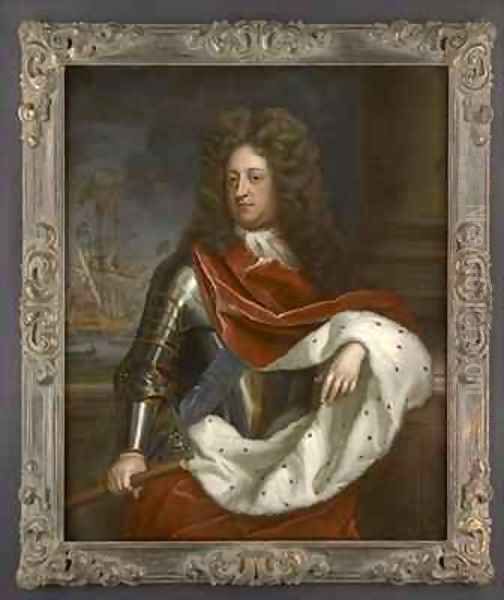
Initially, Dahl may have benefited from some association with Kneller. Some accounts suggest Kneller offered guidance, perhaps less in artistic technique and more in the practicalities of running a successful portrait studio and navigating the patronage system. This mentorship, if it occurred, helped Dahl translate his artistic talent into a profitable career, securing commissions and establishing himself among London's elite. He became adept at capturing the likenesses and projecting the status of his sitters, quickly gaining favour.
The relationship soon evolved into a direct rivalry. While Kneller held the official position of Principal Painter to the Crown and enjoyed extensive royal patronage, Dahl built a substantial practice, attracting a distinguished clientele from the nobility and gentry. Artistically, while both worked within the prevailing late Baroque idiom, stylistic differences emerged. Kneller was often seen as technically brilliant, sometimes prioritizing speed and efficiency in his prolific output. Dahl, while perhaps perceived by some contemporaries as less technically dazzling than Kneller at his peak, developed a style noted for its warmth, sensitivity, elegance, and dignified portrayal of sitters. His handling of paint was often softer, his characterizations more psychologically nuanced. Some art historians note specific stylistic markers in Dahl's work, such as a distinctive treatment of facial features, including defined lip lines and a particular rendering of the nose and bridge.
Patronage and Prominent Sitters
Michael Dahl's success in London was built on his ability to attract and retain high-profile patrons. He became a favoured painter for many members of the aristocracy and political figures, particularly those associated with the Tory party, while Kneller was often more aligned with the Whigs. His studio was busy, producing numerous portraits that adorned the walls of England's grand houses.
His most prestigious commissions included members of the royal family. He painted Queen Anne (1665–1714) both before and after she ascended the throne, capturing her likeness with a blend of regal formality and human warmth. He also painted her consort, Prince George of Denmark (1653–1708). These royal portraits solidified his position at the forefront of English portraiture. His earlier portrait of Queen Christina in Rome remained a significant achievement, demonstrating his ability to operate at the highest levels of European society.
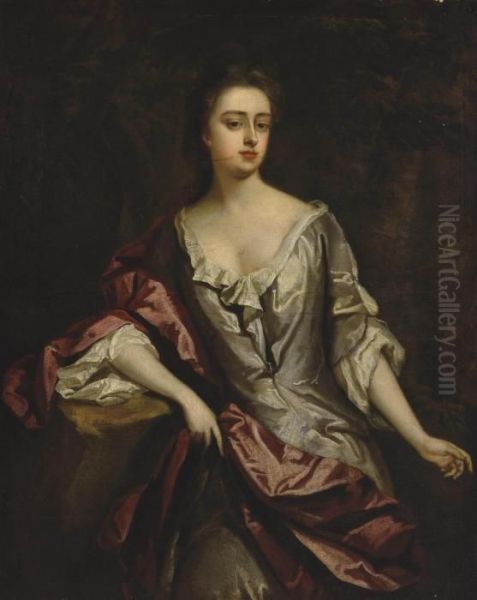
Despite his success, Dahl did experience setbacks. One notable anecdote involves a commission to paint the young Prince William, Duke of Gloucester (George I's grandson). The portrait was apparently unsuccessful or failed to please, reportedly costing Dahl the opportunity for further significant royal favour from the Hanoverian court and potentially a knighthood, an honour bestowed upon his rival Kneller. Nevertheless, Dahl maintained a thriving practice throughout the reigns of William III, Anne, and George I, adapting his style subtly to changing tastes while retaining his core artistic identity. His sitters included numerous dukes, earls, admirals, and prominent ladies of the court, leaving behind a rich visual record of the era's elite. Works like his portraits found in collections at Petworth House demonstrate his strong connections with the nobility.
Artistic Style, Technique, and Influences
Michael Dahl's art is firmly rooted in the late Baroque style, yet it possesses a distinct character shaped by his diverse training and experiences. His Swedish origins provided a foundation influenced by Northern European traditions, likely instilled by Ehrenstrahl. His time in Italy was crucial, exposing him to the grandeur of Roman Baroque and fostering a more fluid, painterly technique. His long career in England meant constant engagement with the demands of British patronage and the styles of his contemporaries.
His portraits are often characterized by their elegance and dignity. He excelled at rendering the rich fabrics and elaborate costumes fashionable during the period – silks, velvets, lace, and powdered wigs are depicted with meticulous attention to texture and detail. This focus on luxurious detail aligns with Baroque aesthetics, although comparisons made in some sources to the earlier Mannerist painter Agnolo Bronzino (1503–1572) likely refer to this shared emphasis on intricate costume rather than a direct stylistic lineage. Dahl's compositions are typically well-balanced, often employing standard portrait formats but imbuing them with a sense of presence and life.
Dahl's handling of paint evolved towards a freer, more confident brushwork, particularly evident after his Italian sojourn. While capable of high finish, his work often retains a certain softness and atmospheric quality. He demonstrated skill in modeling form through subtle gradations of light and shadow, creating convincing likenesses that also conveyed the sitter's personality or social standing. His colour palettes could be rich and harmonious, contributing to the overall sense of refinement. While primarily a portraitist, Dahl was also reportedly adept at landscape sketching, possibly working directly from nature – a practice less common for portrait painters of his time. These sketches, often characterized by their lively and economical strokes, reveal another facet of his artistic sensibility.
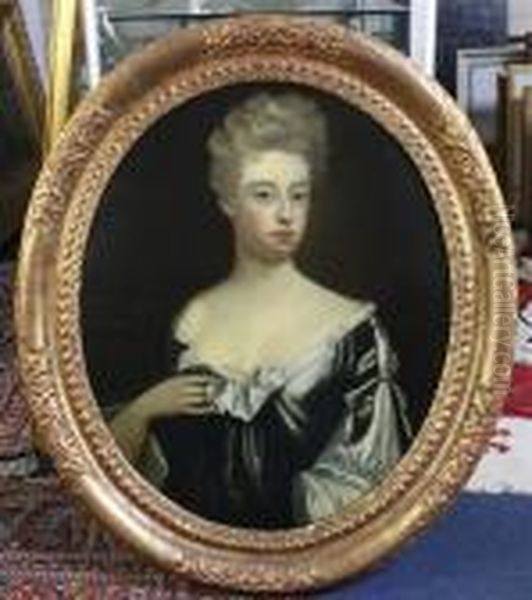
His influences were manifold. Ehrenstrahl provided the initial grounding. The Italian Baroque, particularly the Roman school perhaps exemplified by Maratta, offered lessons in composition and technique. In England, the towering presence of Kneller was unavoidable, both as a rival and an influence, though Dahl consciously forged his own path. Other portraitists active in London during his career, such as John Closterman (1660–1711), Willem Wissing (1656–1687), Jonathan Richardson (1667–1745), and Charles Jervas (c. 1675–1739), formed the competitive milieu in which he worked. Earlier masters like Sir Peter Lely (1618–1680) had set the stage for the type of grand aristocratic portraiture Dahl excelled at. Even the influence of prominent French portraitists like Hyacinthe Rigaud (1659–1743) and Nicolas de Largillière (1656–1746) might be discerned, given the international exchange of artistic ideas.
Representative Works and Collections
Michael Dahl's oeuvre is extensive, comprising hundreds of portraits. While many remain in private collections or the historic houses for which they were commissioned, key examples can be found in public institutions. The National Portrait Gallery in London holds several important works, including Dahl's own compelling Self-Portrait painted around 1691. This work showcases his confident handling of paint and his ability to convey character – presenting himself as a sophisticated and accomplished artist.
Other notable works include his various portraits of Queen Anne and Prince George of Denmark, which can be found in the Royal Collection (including at Windsor Castle) and other galleries. Portraits of leading figures like the Duke of Chandos, Admiral Sir Cloudesley Shovell, and numerous members of the nobility further exemplify his skill and the breadth of his clientele. His group portraits, such as the series known as the "Petworth Beauties," demonstrate his ability to handle more complex compositions while maintaining individual likenesses and an overall decorative harmony, rivaling Kneller's "Hampton Court Beauties." Studying these works reveals his consistent ability to blend formal representation with a sense of intimacy and psychological insight.
Later Life, Legacy, and Unresolved Questions
Michael Dahl continued to work actively in London well into the 18th century, maintaining his reputation even as artistic tastes began to shift towards the Rococo. He remained a respected figure in the London art world until his death on October 20, 1743. He was buried in St James's Church, Piccadilly, a testament to his established position within English society.
His legacy is that of a highly skilled and sensitive portrait painter who made a significant contribution to British art during a key transitional period. As a Swedish artist who achieved prominence abroad, he represents the internationalism of the Baroque era. He provided a stylish and often more reserved alternative to the sometimes flamboyant work of Kneller, capturing the likenesses of a generation of British elites with elegance and perception. His influence can be seen in the work of subsequent portraitists who admired his refined style and painterly technique.
Despite his success, aspects of Dahl's life and work remain subjects of discussion for art historians. The precise details of his birth and early education are still debated. The exact nature of his relationship with his teacher Ehrenstrahl, and the conflicting (and likely erroneous) suggestion in one source that Ehrenstrahl was his father, adds a layer of complexity. Attribution questions occasionally arise, particularly concerning early works and their relationship to Kneller's studio output. The full story of his personal life, including details of his family and his experiences navigating the social and religious complexities of his time (especially his conversion to Catholicism), is not fully documented. Anecdotes, like the misattribution of his self-portrait at one time, highlight the challenges in fully reconstructing the careers of historical artists.
Conclusion: An Enduring Presence in Portraiture
Michael Dahl remains a pivotal figure in the history of British and Swedish art. Emerging from Stockholm, he embraced the opportunities offered by the major art centers of Europe, ultimately finding fame and fortune in London. For over five decades, he painted the faces of England's ruling class, creating a body of work notable for its technical skill, refined aesthetics, and insightful characterization. As the primary rival to the dominant Sir Godfrey Kneller, Dahl offered a distinct artistic voice, one marked by elegance, dignity, and a subtle warmth. His journey from Sweden to the heart of the London art world, his navigation of patronage and rivalry, and his enduring artistic achievements secure his place as a master of late Baroque portraiture. The unresolved questions surrounding his life only add to the intrigue of this talented artist who successfully bridged nations and artistic traditions.